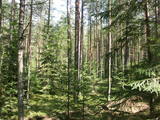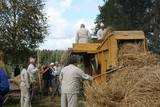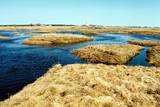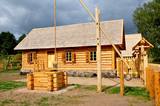| Nr | Nosaukums | Apraksts |
|---|---|---|
|
Ap 25 km gara un līdz 1,5 m plata vaļņveida reljefa forma Adzeles pacēluma dienvidu malā, kas apaugusi ar skujkoku mežu. Latvijā reti biotopi un nozīmīga daudzu aizsargājamu augu un dzīvnieku sugu dzīves vieta. Numerenes valni var ļoti labi "izjust", braucot pa Kārsavas - Tilžas ceļu. Dabas parkā atrodas slēpošanas kalns "Nūmerene".
|
||
|
Pie Priedīšu mājām izveidotā dabas taka iepazīstina ar Dziļezeru un tā apkārtni. Dziļezers ar Riebezeru un pārējie – Mazezers, Auziņu ezers, Skujas ezers un Bruņķītis atrodas subglaciālā (ledāja veidotā) iegultnē, kuras krastos aug dažādu tipu, t.sk. platlapju meži - aizsargājami biotopi. Ietilpst Dziļezera un Riebezera dabas lieguma teritorijā. Atrodas Ziemeļvidzemes biosfēras rezervātā.
|
||
|
Ēdoles vārds ikvienam Latvijas apceļotājam saistās ar Ēdoles pili. Tās pirmsākumi meklējami 13. gs. vidū, bet pils piebūves tapušas 16. un 19. gs., kad izveidoja iekšējo pagalmu. 19. gs. 30. gados īstenotās pārbūves laikā pils fasādes ieguva tagadējo - neogotisko izskatu. Laikā no 16. gs. - 1920. g. Ēdoles pils atradās baronu Bēru dzimtas īpašumā. 1905. g. nemieru laikā to nodedzināja, bet 1907. g. atjaunota. Ēdoles pils saistīta ar daudzām leģendām un spoku stāstiem. |
||
|
Saimniecībā tiek audzētas gaļas šķirnes (Suffolkas) aitas un piena šķirnes (Ostfrīzijas) aitas. Ganāpmulka aizsardzībai saimniecībā strādā ar sargsuņiem, Pireneju kalnu suņiem, kas ir pasaulē arī plaši pazīstama suņu šķirne mājlopu un mājputnu apsargāšanai no lielākiem un mazākiem plēsējiem. Saimnieki piedāvā iegādāties premium klases, saimniecībā audzētu, jēru gaļu un aitu piena produktus- Fetas tipa sieru, grilsieru, jogurtu bez piedevām un vairāku veidu saldējumus. |
||
|
Pāvilostā ir trīs parki. Pāvilostas centrā (pie kultūras nama) atrodas Piecdesmitgades parks, kuru 1929. g. iekopa skolotājs un novadpētnieks Ernests Šneiders. Vienu ozolu tajā esot iestādījis Latvijas Valsts prezidents Gustavs Zemgals. Simtgades parks ar piemiņas akmeņiem tapa Sakas labajā krastā jau kā turpinājums iesāktajam. Vecākais no Pāvilostas parkiem - Upesmuižas parks (19. gs.) atrodas tuvu Liepājas – Ventspils šosejai. Upesmuižas pils nav saglabājusies (nodedzināta 1905. g.). Parkā apskatāms sens akmens sols (perimetrs 5,55 m) un Upesmuižas parka Lielais akmens. Domājams, tas ir kultakmens. |
||
|
Vecajā baznīcas skolā ierīkotajā Limandas ēdnīcā var nobaudīt garšīgus ēdienus. Gardo ēdienu gatavošanā ir izmantoti dabīgi un apkārtnes tīrumos audzēti dārzeņi. Zivju ēdieni ir gatavoti no vietējo zvejnieku piegādātajām zivīm. Blakus ēdnīcai atrodas rokdarbu veikals. |
||
|
Šī skata dēļ ir vērts braukt arī no tālienes. No Latvijas mērogā iespaidīgā reljefa veidojuma paveras tāls skats līdz pat Hānjas augstienei Igaunijā, kur zinātājs atpazīs arī Lielo Munameģi – Baltijas augstāko virsotni.
|
||
|
The tour starts at former Hanseatic port town Gdansk with its pretty Old Town, then continues to Malbork, an impressive fortified medieval castle and on to laid-back Formbrok with a magnificient Gothic cathederal. The route crosses the Mazurianlake district where hundreds of lakes are connected to rivers and canals, best expereinced from the deck of a boat. Continue to Wigry National Park with walking trails and interesting archaeological and cultural remains. Further into Lithuania, Dzukija National Park has several well preserved traditional farmsteads and villages which are well worthavisit. It's a good place to experience Lithuanian crafts and traditions, for instance bee keeping. Then the route goes via Kaunas to the Curonian Spit formed by shifting sand dunes between its lagoon and the sea. Pretty little villages are located along its length. Next the route goes to the sea resort Palanga with a great Amber Museum and on to Latvia. Stop at Pape Nature Park, a diverse mosaic of nature’s ecosystems, where wild horses and oxen breed. Slītere National Park shows the historical development of the Baltic Sea. Cape Kolka is a prime spot for bird migrations, Slītere lighthouse provides a great view of the surrounding forests and traditonal Liv villages, one of the smallest ethnic groups in the world. The Ķemeri National Park includes different types of wetlands and vast bogs. It is famous for its sulphur springs. Walk a Great Heath trail there and try the curative spring water. Further on Gauja National Park is formed around the ancient valley of the Gauja river with picturesque sandstone cliffs from the Devonian period. Here are many historic monuments – medieval castles, churches and ancient settlements which you can see crossing the valley on a cable car. Ligatne Nature trails offer a chance to observe local wild animals. Saaremaa's landscape is characterised by large juniper growths, dolomite cliffs, windmills, medieval churches and the famous Kaali meteorite lake. It also retains a very Estonian soul. Sooma National Park has contrasting swamps. Walk a beaver trail there and try 'bog-shoeing'. Lahemaa National Park has a rugged coastal andscape with big boulders, traditional fishing villages, forest trails and romantic manor houses. From Tallin take a ferry to Helsinki, from where it is an easy trip to Nuuksio National Park, home to an endangered flying squirrel. The landscape here is dominated by valleys and gorges, rocky hills covered by lichen and sparse pine forest that is very different to the previous parks. Well-equipped walking trails have several scenic views. |
||
|
Kurgjas lauku muzejā var iepazīties ar Igaunijas 19. gadsimta atmodas laika dižvīra Kārļa Roberta Jākobsona dzīvi un darbu, ar viņa celtās lauku sētas ikdienas rūpēm. Tā kā lauku sētā līdz pat šodienai saimnieki nodarbojas ar lopkopību, var iepazīt liellopus, aitas un zirgus, ieskatīties restaurētajās palīgēkās – govju kūtī, klētī, dzirnavās un rijā. Lauku darbus var izmēģināt arī paši. Pēc pasūtījuma muzejā iespējams nobaudīt nacionālos ēdienus. |
||
|
Pirts zeme ir kā atsevišķs ciemats, kur uz savas ādas varēsiet izbaudīt dažādas pirtis un to savdabību. Brīnišķīga iespēja novērtēt katras pirts garu un krāt zināšanas par to vēsturi. |
||
|
Latvia is among one of the world’s three most important bird migration paths, and during migration seasons tens of thousands birds can be seen at one place. The tour will spent significant time along the sea coast in order to catch the highlights of migration. In spring time also flood-lands become alive with activities of thousands of birds and provide great atmosphere for birdwatchers. This tour explores different biotops to get the best impressions of the spring time migration. |
||
|
Meklējams Jaunpiebalgas dienviddaļā, Jaunpiebalgas vidusskolas teritorijā (no skolas uz dienvidiem). Tas atklāts 1977. g. senā lauku mājā, kuru klāj niedru jumts. Muzeja ekspozīcija stāsta par apkaimes ievērojamākajiem cilvēkiem, notikumiem, vēsturi un tradīcijām. |
||
|
Kapteiņa A. Bertholda vecāku kapu
vieta ar savdabīgu kapa pieminekli.
|
||
|
Viena no interesantākajām Rīgas īpaši aizsargājamām dabas teritorijām, kas veidota piekrastes biotopu – kāpu un jūrmalas pļavu un tajā ligzdojošo putnu un augu sugu (atrodas 29 % no orhideju sugu) aizsardzībai. Dabas liegumā izveidota marķēta izziņas taka ar putnu vērošanas torni - Latvijā vienīgo brīvdabas skatu torni, kas pielāgots cilvēkiem ar ratiņkrēsliem.
|
||
|
Igaunijas vizuāli izteiksmīgākais karsta lauks 125 ha platībā ar dažādām karsta procesu izpausmēm – pazemes strautiem, Jēlehtmes (Jõelähtme) upes sausgultni, karsta avotiem, piltuvēm, gravām, alām, pamatiežu atsegumiem, savdabīgu akmens „sēni” u.c. Pavasaros tas applūst, bet mazūdens periodā labi apskatāmas minētās karsta formas.
|
||
|
Viens no labākajiem veidiem, kā iepazīties ar sidru, ir paviesoties kādā no sidra darītavām, kur klātienē var redzēt, kā sidrs tiek gatavots. Vairākas sidra darītavas piedāvā apmeklējumus, kuros sidrdari parādīs ražošanas procesu, ļaus nodegustēt savu produkciju un pastāstīs par to. Sidrdari pieņem apmeklētājus pēc iepriekšējas pieteikšanās. Rezervējiet savu apmeklējumu laikus, lai mazajās saimniecībās, kur bieži vien strādā tikai pati ģimene vai pāris darbinieku, sidrdari var paspēt apvienot tūristu uzņemšanu ar savu ikdienas darbu. Parasti sidra darītavas uzņem viesus visu cauru gadu, dažos gadalaikos ir iespējams vērot arī ražošanas procesu, tādēļ sidra darītavas apmeklējumam ieplānojiet apmēram 2 stundas. |
||
|
Ainavisks, ap 340 m garš un līdz 15 m augsts atsegums, kas atrodas nepilnu kilometru lejpus Raunas ietekas Gaujā, kreisajā pamatkrastā. To veido sarkandzeltenīgi Gaujas svītas smilšakmeņi. Gar Kazu ieža austrumu daļas pakāji izkaisīiti vairāki lieli laukakmeņi, kas ērti iekārtojušies uz smilšakmeņos izskalotas pamatnes. |
||
|
Leimaņu ciems ir sācis veidoties 20.gs. sākumā kādreizējā kroga apkārtnē. Vienā no tās vēsturiskajām ēkām atrodas arī amatu māja "Rūķīši". Ēkā ir dažādas tematiskās istabas - aušanas, novadpētniecības, maizes, saimes, senlietu un Ulmaņlaika istaba. Viesiem ir iespēja aplūkot un iemācīties maizes mīcīšanas un tapšanas procesu, izstaigāt Latvju zīmju parku, iepazīties ar Leimaņu pagasta vēsturi un iemēģināt roku aušanas procesā. |
||
|
Restorāns atrodas viesu mājā "Liedags" Liepājas - Venstpils šosejas malā 4.5 km no Jūrkalnes Ēnavītes upītes krastā. |
||
|
Izskata ziņā – visnotaļ etnogrāfisks ciems, kam ir sādžas plānojums un Latgales novadam raksturīgās ēkas ar apdarinātiem logiem un ažūrām fasādēm. Slutišķu vecticībnieku mājā ir izveidots muzejs (Naujenes novadpētniecības muzeja filiāle), kurā var iepazīt vecticībnieku kultūrvidi un tradīcijas. No blakus esošā Daugavas ielejas krasta paveras viena no neparastākajām Latvijas kultūrainavām. Tiem, kam patīk doties garākos pārgājienos, var aizstaigāt līdz aptuveni kilometru tālajai Slutišku kraujai, no kuras paveras ne mazāk iespaidīgi skati. Vasara 2018.
|
||

























